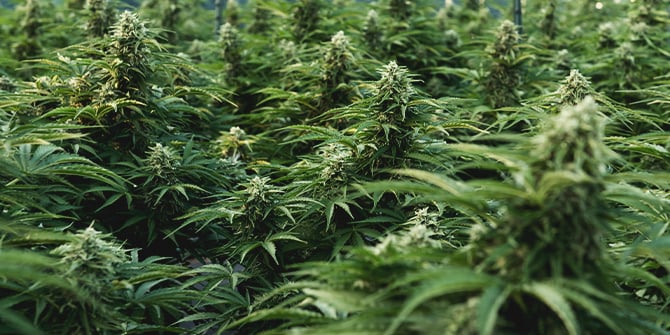 Weed Grow Guide by Royal Queen Seeds
Weed Grow Guide by Royal Queen Seeds
- Growing weed step by step
- Cannabis growing basics
- Choosing your seeds
- How to germinate seeds
- The cannabis vegetative stage
- The cannabis flowering stage
- Harvesting cannabis
- Trimming, drying, and curing
- Choosing pots and soil
-
Growing indoors
- A Complete Overview Of Growing Cannabis Indoors
- Cannabis Cultivation Tips: How To Set Up Indoor Grow Lights
- How Many Cannabis Plants Can You Grow Per Square Metre?
- Indoor Cannabis Growing: Relative Humidity and Temperatures
- Hydroponics Cannabis Growing Guide (with diagrams)
- Cannabis Micro Growing: Growing Great Weed in Tiny Spaces
- Growing outdoors
- How to grow autoflowering cannabis
- Cannabis nutrients and pH
- Cannabis troubleshooting: Nutrients
-
Cannabis troubleshooting: Growing
- Cannabis Seed Germination — Troubleshooting Guide
- How to Deal With Pythium (Root Rot) in Cannabis Plants
- Slow Cannabis Plant Growth And What You Can Do About It
- How to Deal With Leggy Cannabis Seedlings
- Watering Your Cannabis: How to Fix Overwatering and Underwatering
- Understanding Male, Female, And Hermaphrodite Cannabis
- Identifying and Treating Common Cannabis Ailments
- How To Revive a Sick Cannabis Plant
- How to Avoid Mouldy Weed During Drying and Curing
- How to Prevent and Treat Dry and Crispy Cannabis Leaves
- What Cannabis Leaves Can Tell You
- Causes and Solutions for Yellow Cannabis Leaves
-
Cannabis Strains Grow Report
- HulkBerry Automatic Grow Report
- Blue Cheese Auto Grow Report
- Purple Punch Automatic Strain Grow Report
- Triple G Automatic Grow Report
- Do-Si-Dos Automatic Grow Report
- Green Gelato Automatic Grow Report
- Haze Berry Automatic Grow Report
- Purple Queen Automatic Grow Report
- Cookies Gelato Automatic Grow Report
- Sherbet Queen Automatic Grow Report
- Sweet Skunk Automatic Grow Report
- Medusa F1 Grow Report
- Cannabis plant training
-
Weed growing tips
- The Cannabis Plant Anatomy
- How to preserve seeds - UK
- How Much Sunlight Do Outdoor Cannabis Plants Need To Grow?
- How to Control and Prevent Stretching in Cannabis Plants
- My Cannabis Plants Are Growing Too Tall: What Should I Do?
- Should You Worry About Purple Or Red Cannabis Stems?
- What To Do When Your Indoor Cannabis Won’t Flower
- How To Protect Your Cannabis Plants From Heat Stress
- How To Tell If Your Female Cannabis Plant Has Been Pollinated
- Growing Medical Marijuana
- Bud Washing: How to Clean Your Weed
- Understanding Cannabis Yield per Plant
How to Grow F1 Hybrid Cannabis Seeds


Contents:
F1 hybrid cannabis varieties offer increased resistance, bigger yields, higher concentrations of cannabinoids and terpenes, and unparalleled uniformity. Every grower should experience what they have to offer at least once in their cultivation career. Below, you'll learn exactly how to grow F1 hybrid marijuana, both indoors and outdoors.
Germination
If you're wondering how to germinate marijuana seeds, the process of germinating F1 hybrid cannabis seeds is almost identical to doing so with other varieties—with one exception. Owing to their superior resistance to disease, F1 hybrid seeds are less likely to autumn prey to root pathogens that have the potential to wipe out seedlings. However, they aren’t entirely immune. Here are the most common ways to pop seeds:
⛏️ Direct sowing
🌱 Soil Plugs: Soil Plugs contain beneficial microbes and nutrients that give seedlings a head-start in life.
🥛 Glass of water method
🧻 Paper towel method
Unless you’re opting for direct sowing or Soil Plugs, you’ll need to place your sprouted seeds into their growing medium when the young taproot reaches a length of 1–2cm. These tips will help your F1 hybrid cannabis strains thrive in these critical early stages:
- Avoid overwatering: Applying too much water to your seedlings can suffocate the roots and predispose them to disease.
- Ensure proper drainage. Use perlite, vermiculite, and sandier soil to improve drainage.
- Don’t wait too long to turn on the lights: Seedlings require light as soon as shoots emerge from the soil. Without adequate light, they’ll become leggy and weak.
- Don’t feed: Your seedlings won’t require additional nutrients for at least one week, depending on the contents of your growing medium
- Control humidity: Use a humidity dome to keep an average relative humidity of 70%.
Typically, the seedling stage lasts around one week after the shoot breaks the surface of the soil. After this, your plant will enter the vegetative phase of the growing cycle.
Growing Photoperiod F1 Hybrids Indoors
Photoperiod F1 hybrid plants are those that require a change in the light cycle in order to flower. They grow in a similar fashion to both regular and feminised photoperiod varieties. However, these seeds produce much more uniform plants that exhibit superior yields and improved phytochemical profiles. There are many different approaches that cultivators can take when growing F1 hybrid cannabis indoors.
The Best Lighting for F1 Hybrids
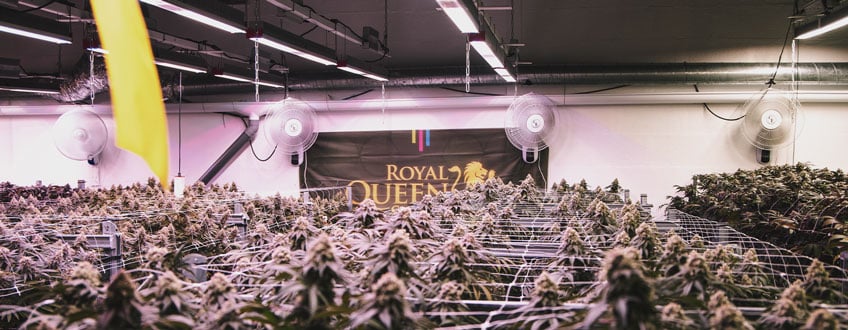
Plants need photons to conduct photosynthesis, create energy, and survive. There are many lighting options available, including CFL, HID, and LED. Regardless of the type of light you choose, you need to provide the optimal light intensity; enough to drive photosynthesis without causing light stress.
There are three primary ways to dial in light intensity indoors. First, you can simply abide by the manufacturer's instructions as they apply to your growing area. If you want to get a bit more specific, consider investing in a lux meter. When measuring lux, you’ll want to aim for different ranges during different stages of the growing cycle:
- Seedling stage: 5,000–7,000 lux
- Vegetative stage: 15,000–50,000 lux
- Flowering stage: 45,000–65,000 lux
Ideally, you’ll use a quantum PAR meter to dial in your light intensity. They’re more expensive than lux meters, but they provide more valuable data. Aim for a PAR level of 300–400 µmols/m²/sec to achieve optimal growth.
Light intensity aside, the light cycle also plays a fundamental role when growing photoperiod F1 hybrid cannabis genetics. During veg, growers typically keep their lights running for 18–24 hours each day. To induce flowering, you’ll need to reduce the light cycle to 12 hours per day right up until harvest.
Growing Medium and Nutrition for F1 Hybrids
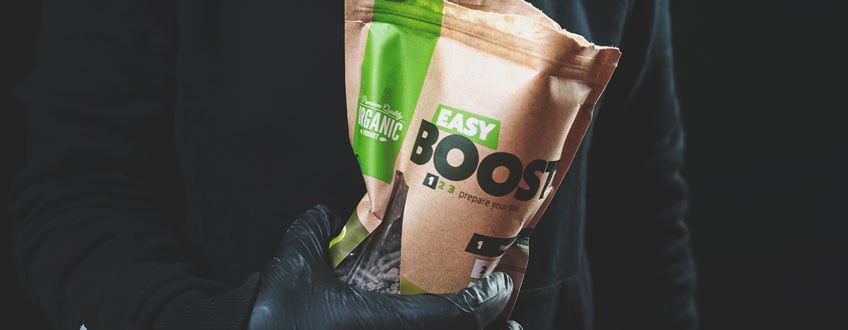
Alongside lighting, the growing medium and nutrients you use will have a significant impact on the yield of your F1 hybrids.
Whatever approach you take, you need to consider the demands of F1 hybrid strains during different stages of the growing cycle. During the vegetative phase, plants have a higher demand for nitrogen. They use this element as the basis for amino acids, which are used to create structural proteins important for growth. If you want to keep things as simple as possible, RQS Easy Grow Booster Tablets contain the perfect ratio of nutrients for this stage of growth.
When growing photoperiod F1 hybrid cannabis genetics indoors, growers have complete control over when their plants flower. Buds will start to develop when you reduce the light cycle to 12 hours on and 12 hours off; this photoperiod tricks plants into thinking autumn is approaching. During bloom, the nutrient demands of plants change once again; they require less nitrogen but higher quantities of potassium and phosphorus. RQS Easy Bloom Booster Tablets cover all of these bases.
Want pro-grade nutrient control? Download our Pro Growing Guide for exact N-P-K ratios by stage, PPM/EC benchmarks, and practical feeding advice to ensure your F1 hybrids achieve maximum yield.
Free Advanced
Growing Guide!
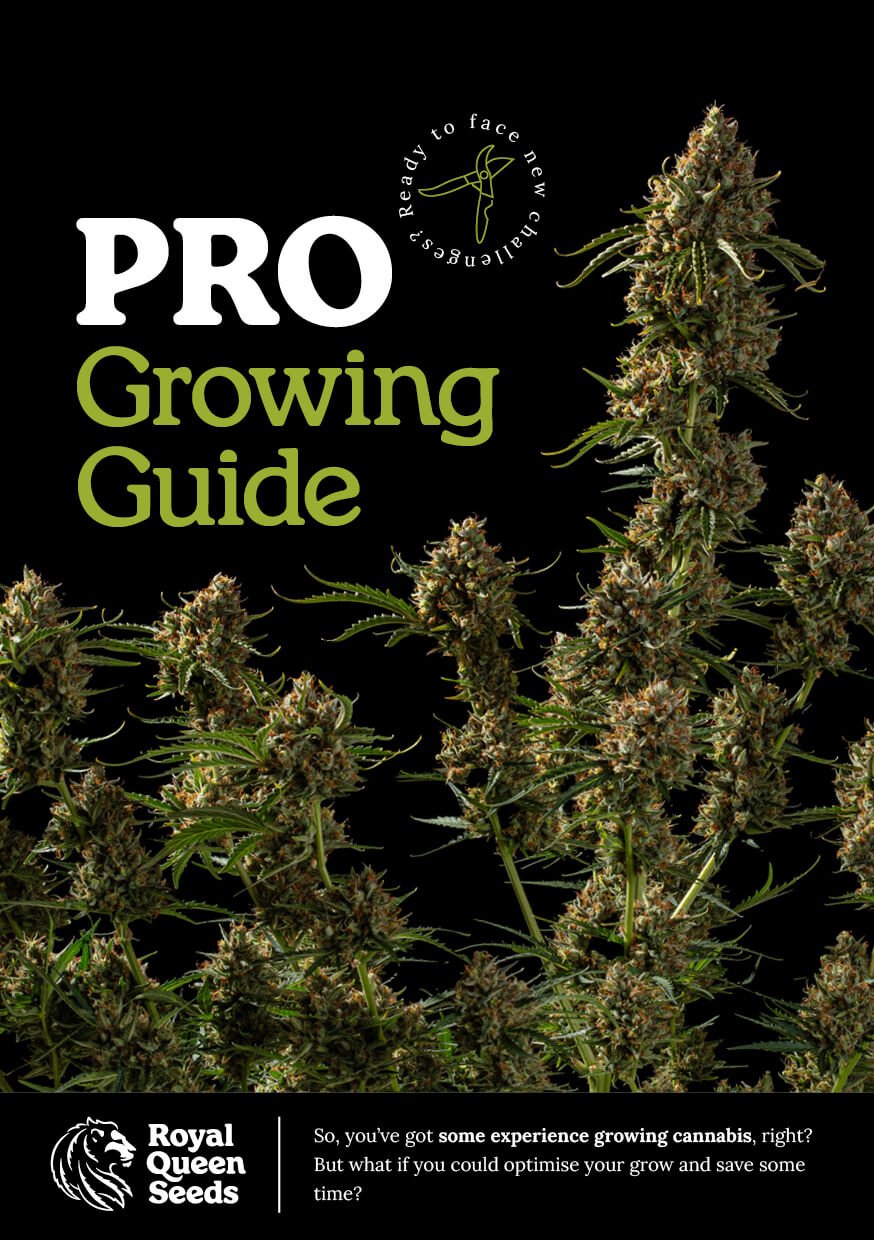
Temperature and Humidity
Indoor growers have almost complete control over the climate within their growing space. Use a combination of fans, air conditioning, and heaters (depending on your climate) to maintain the following daytime temperature ranges:
- Seedling stage: 20–25°C
- Vegetative stage: 22–28°C
- Flowering stage: 20–26°C
You’ll also need to keep track of humidity (the amount of moisture in the air) to keep your F1 hybrid cannabis plants happy and healthy. Cannabis does well with high levels of humidity early on in life, before requiring much less during the flowering stage. Use fans, humidifiers, and dehumidifiers to maintain these humidity ranges:
- Seedling stage: 65–70%
- Vegetative stage: 40–70%
- Flowering stage: 40–50%
You can use a device called a thermo-hygrometer to measure temperature and relative humidity simultaneously.
Integrated Pest Management
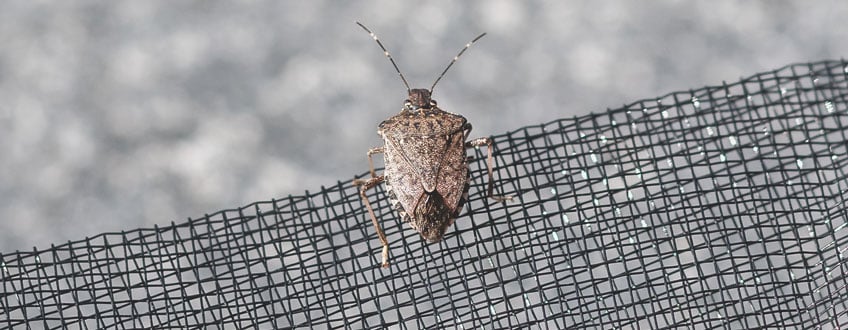
F1 hybrid cannabis varieties possess superior resistance to pests and disease compared to strains. However, they aren’t completely invulnerable to these threats. The Agriculture and Horticulture Development Board defines[1] integrated pest management (IPM) as a coordinated and planned strategy for the prevention, detection, and control of pests, weeds, and diseases. These problems are certainly more prevalent when growing F1 hybrid cannabis strains outdoors, but they can still work their way into indoor cultivation spaces.
When growing F1 hybrids indoors, use the following tips to keep your cannabis plants pest and disease-free:
- Use beneficial microbes: Inoculating your plant roots with mycorrhizal fungi and Trichoderma can boost growth and protect the root system against soil pathogens.
- Instal insect screens: Placing insect screens over any entrances to your growing space, such as inlets and outlets, creates a physical barrier to keep pests out.
- Use sticky traps: These are a great preventative technique, as well as a treatment, for pests such as fungus gnats and thrips.
- Practise good hygiene
Training and Defoliation
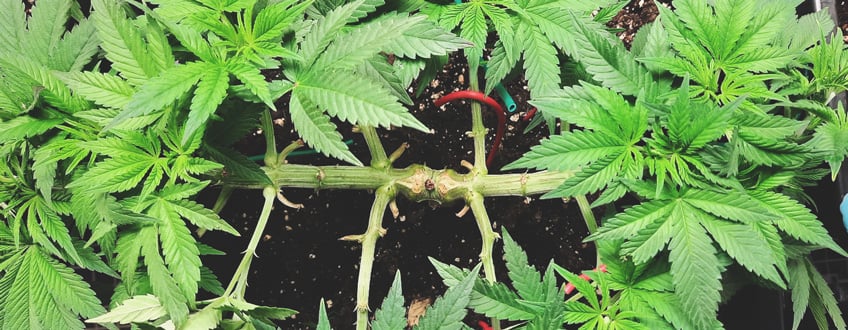
When growing F1 hybrid cannabis in a tent, you can use several different training techniques to optimise yields. These include:
- LST: Otherwise known as low-stress training, LST involves tying the main growing tip to the rim of the container to promote lateral growth and uniform buds. Because LST doesn’t involve inflicted controlled tissue damage, it doesn’t adversely affect plant growth.
- Super cropping: This advanced training technique vastly increases yields. Super cropping involves gently squashing and bending branches to manipulate the shape of the canopy in a way that increases flower production.
- Lollipopping: As the name implies, lollipopping is a pruning technique that removes the lower branches and bud sites to create a lollipop shape. This drives resources up toward the canopy, resulting in fewer but larger buds.
- Topping: Cutting the growing tip off of a cannabis plant distributes growing hormones to other areas of the plant, thus promoting lateral growth and limiting plant height. For optimal results, remember to perform this technique exclusively on F1 photoperiod plants, not F1 autos.
- Defoliation: The controlled removal of fan leaves helps to increase aeration and expose bud sites to more light.
Can You Grow More Than One Variety in the Same Growing Tent?
Absolutely. You can grow different F1 hybrid cannabis strains in the same tent at the same time. However, you’ll experience greater success if you grow varieties with a compatible height and flowering time. This will help to prevent one plant from overshadowing the other and producing poor results.
When and How to Harvest F1 Hybrid Photoperiod Cannabis Plants Indoors
The length of the life cycle of F1 hybrid photoperiod plants depends entirely on when you switch them to flower. After changing the light cycle, they’ll typically take around 8–9 weeks to finish blooming. From here, you’ll need to harvest your plants and process your flowers correctly.
You have two options: cut your plants at the base and hang them upside down to dry, or cut off each individual bud and load them into a Herb Dryer.
Dry your flowers in a dark room with a relative humidity of around 50%. You’ll know they’re ready when the stems snap instead of bend. Once dry, place your flowers into curing jars with Moisture Fighters for at least six weeks to improve their flavour and smoothness.
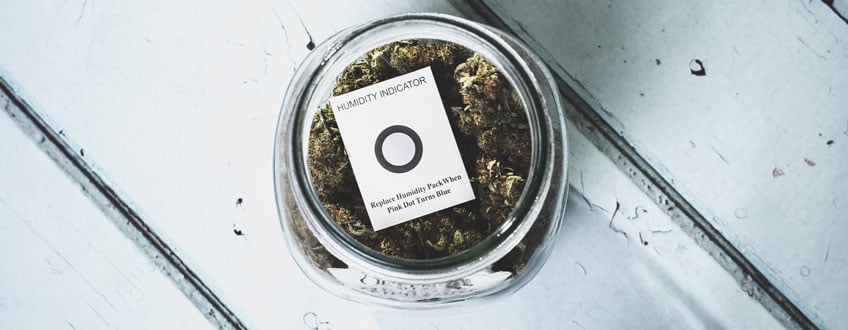
Growing Autoflowering F1 Hybrid Cultivars Indoors
F1 hybrid cannabis varieties aren’t limited to photoperiod strains; you’ll also find autoflowering cultivars such as Orion F1, Titan F1, and Medusa F1. Much like other autoflowering strains, these varieties are easy to cultivate. They’re small and stealthy, impressively potent, and surge from seed to flower in a matter of weeks. You can grow them in much the same way as their photoperiod counterparts. However, there are some important differences.
Lighting Differences
Autoflowering strains don’t require a change in the light cycle to begin flowering; they run off of an internal genetic clock instead. Many growers maintain a constant light cycle of 24 hours during the vegetative phase, and then reduce it slightly to 20 hours during flowering. However, you can leave your lights on for 24 hours each day throughout the entire growing cycle. This will speed up growth, but obviously comes with higher electricity costs.
Training Differences
Training autoflowering plants results in improved yields when done correctly. Because F1 hybrid autos offer bigger yields from the get-go, applying training techniques pushes production potential even further. But hold on a second! You should only use low-stress training when growing autoflowers. Because they grow so quickly, they have little time to recover from high-stress methods.
When and How to Harvest
You should harvest, trim, dry, and cure your flowers in the exact same way as mentioned above. While autos require a different approach when growing, there are no differences when it comes to harvesting buds and prepping them for smoking.
Growing Photoperiod F1 Hybrids Outdoors
Growing weed outdoors poses a whole different set of challenges. Specific climates, pests, and diseases, adverse weather, and a general lack of control over the elements make it slightly more difficult, but all the more rewarding.
Luckily, F1 hybrid cannabis plants are more suited to deal with these obstacles. Their hybrid vigour, which results from the crossing of two highly inbred parent lines, makes them less susceptible to pests, disease, dryness, and excess moisture.
Consider Your Growing Season
You can’t simply flick a switch and force your photoperiod plants to start flowering outdoors. Instead, you’ll need to wait for them to respond to natural light cycles. However, things start to get cold very quickly further north. Greenhouses and polytunnels can extend the growing season. This will allow you to get your plants outdoors earlier, and protect them from adverse weather during their final stages of development.
If you grow weed outdoors further south, count yourself lucky! You don’t have to deal with a short growing season. But that doesn’t mean you should let your guard down. You still need to protect your plants against scorching heat waves and droughts.
Plant Placement and Protection
Where you place your plants can greatly affect their performance. Ideally, situate them in a south-facing position where they’ll receive as much sunlight during the day as possible. With that said, if you live in a particularly hot region, your plants will benefit from some late-afternoon shade; if you grow in pots, you can simply move them when the weather becomes unfavourable. If your plants are in the ground, then set up some shade cloth to protect them as and when needed.
Growing Medium
Growing outdoors gives cultivators the option of growing in containers, in raised beds, or directly in the ground. If you opt for containers, you have the same growing medium choices as indoor growers. If you prefer to grow in raised beds or directly in the ground, use these tips to keep your F1 hybrid cannabis plants in top shape:
- Start composting: Composting all of your kitchen scraps and garden waste will provide you with free fertility that you can add to your beds annually.
- Be liberal with biologicals: Most outdoor soils are rich with biological life—including beneficial bacteria and pathogens. You can tip the scale in your favour by inoculating your plants and beds with mycorrhizal fungi, Trichoderma, and rhizobacteria.
- Don’t till: After working your soil in the first year, refrain from tilling going forward. The no-till method keeps mycelial networks and soil food web populations thriving.
- Use dead mulches: Adding a thin layer of grass clippings, compost, or dead leaves to the surface of your soil will protect the soil food web and kickstart nutrient cycling.
- Use cover crops: Keep your soil covered during winter months using hardy cover crops such as broad beans and peas. These plants release carbon compounds into the soil and keep populations of beneficial microbes active during the off-season.
Pest and Disease Prevention
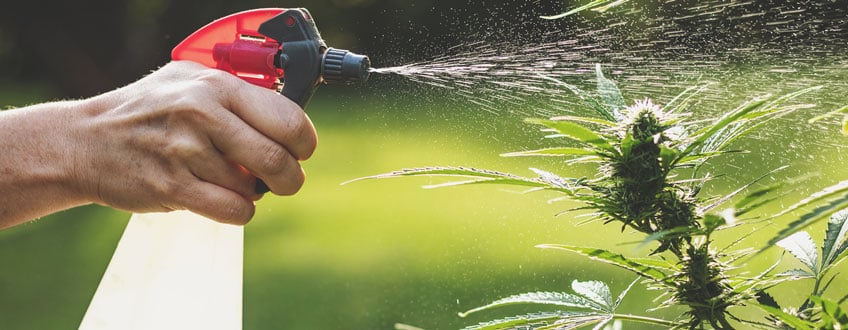
Plant pests and diseases are more common outdoors. Insects roam freely, and diseases can lie dormant in the soil for long periods of time. However, you’re at an advantage when growing F1 hybrid cannabis strains. These cultivars are much more resistant to diseases, and their improved cannabinoid and terpene profiles are more effective at turning away pests.
- Use insect netting: It doesn’t take much to erect insect netting around individual plants or entire beds. These physical barriers are effective at keeping caterpillars, thrips, and even birds off of your plants.
- Avoid chemicals pesticides and herbicides: Although effective in the short term, these chemicals harm the soil food web and allow diseases to gain a foothold in the subterranean microbial matrix.
- Learn how to make natural insecticides: Learn how to turn garlic, tomato leaves, and essential oils into natural pesticides.
- Sow companion plants: Growing companion plants in close proximity to your cannabis plants can help to repel insects, whereas some species attract them, thus drawing them away from your prized crop.
- Grow polycultures: You don’t have to dedicate separate spaces for your companion plants. Select numerous species and grow them directly alongside your cannabis plants. Not only will this benefit the soil, but it will help to minimise the spread of disease among plants of the same species.
When to Harvest
Your plant will reach full maturity from September to October, depending on the strain and when you germinated seeds. Instead of guessing the best time to harvest, you can use a loupe or magnifying glass to take a closer look at these structures:
- Pistils: These are small hairs that protrude from each individual cannabis flower, appearing white during the early flowering stage and turning orange as plants approach maturity. Aim to harvest buds when 60–70% of the pistils turn dark orange.
- Trichomes: These are the small glandular structures that give cannabis buds their frosty appearance. When buds are immature, trichomes are translucent in appearance. However, they become more milky and opaque as plants approach harvest.
Polytunnels and greenhouses come in handy during late flowering. Heavy rain and high levels of moisture drastically increase the risk of mould during this time.
Growing Autoflowering F1 Hybrid Cannabis Varieties Outdoors
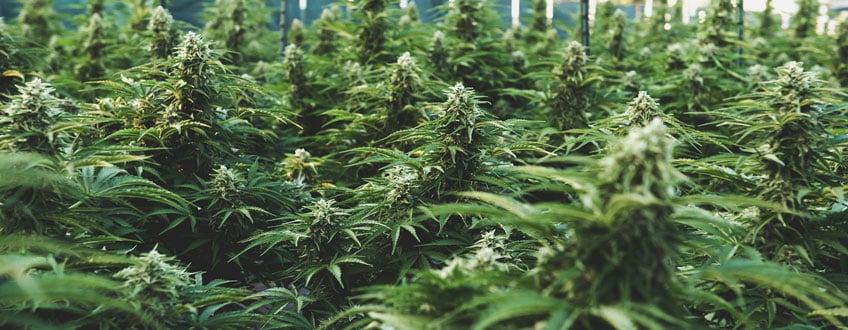
Photoperiod plants tend to perform well outdoors, but what about autoflowering F1 hybrids? Well, if you know anything about autos, you’ll know that they can handle just about anything. Throw in the increased vigour of F1 genetics, and you have yourself a plant capable of thriving with minimal intervention. Overall, you should apply all of the tips above to your outdoor auto F1 hybrids.
When to Plant
Autoflowering F1 hybrid strains have an entire life cycle of 60–85 days. The speed with which autos grow gives cultivators a lot more flexibility. You don’t need to act with urgency as soon as the last frost passes—even if you live in a cooler climate. Rather, you have the freedom to sow seeds later in the growing season. This enables growers with limited space to take advantage of successive harvests.
Those with more room to play with might choose to sow photoperiods early, and follow up with autoflowers later in the season. Alternatively, you can sow photoperiods and autoflowers at the same time for an early auto harvest while you wait for the rest to mature.
Ideal Climate
Autoflowering genetics are native to places like Siberia—a cold part of the planet with a brief growing season. While they also perform well in warmer areas, they're an ideal choice for growers that live in northern latitudes; you’ll have racks of buds drying safely, way before the first frost sets in.
When and How to Harvest
You should harvest your outdoor autoflowering F1 hybrid plants in the exact same manner as their indoor counterparts. Depending on the strain, prepare to harvest and process your buds in as little as 60 days after shoots emerge from the soil.
Once You Go F1, You Never Go Back
You’re now aware of exactly how to care for F1 hybrid cannabis strains, from tall and prosperous photoperiod varieties to small and speedy autoflowering cultivars. If you’re used to growing polyhybrid varieties, then you’ll relish the vigour, health, productivity, and potency of F1 hybrid strains. Whether you opt for photoperiods or autoflowers, you’ll undergo such a positive experience that you’ll likely never go back!
- Integrated pest management (IPM) hub | AHDB https://ahdb.org.uk
 Grow Guide Topic Finder
Grow Guide Topic Finder
- Growing weed step by step
- Cannabis growing basics
- Choosing your seeds
- How to germinate seeds
- The cannabis vegetative stage
- The cannabis flowering stage
- Harvesting cannabis
- Trimming, drying, and curing
- Choosing pots and soil
-
Growing indoors
- A Complete Overview Of Growing Cannabis Indoors
- Cannabis Cultivation Tips: How To Set Up Indoor Grow Lights
- How Many Cannabis Plants Can You Grow Per Square Metre?
- Indoor Cannabis Growing: Relative Humidity and Temperatures
- Hydroponics Cannabis Growing Guide (with diagrams)
- Cannabis Micro Growing: Growing Great Weed in Tiny Spaces
- Growing outdoors
- How to grow autoflowering cannabis
- Cannabis nutrients and pH
- Cannabis troubleshooting: Nutrients
-
Cannabis troubleshooting: Growing
- Cannabis Seed Germination — Troubleshooting Guide
- How to Deal With Pythium (Root Rot) in Cannabis Plants
- Slow Cannabis Plant Growth And What You Can Do About It
- How to Deal With Leggy Cannabis Seedlings
- Watering Your Cannabis: How to Fix Overwatering and Underwatering
- Understanding Male, Female, And Hermaphrodite Cannabis
- Identifying and Treating Common Cannabis Ailments
- How To Revive a Sick Cannabis Plant
- How to Avoid Mouldy Weed During Drying and Curing
- How to Prevent and Treat Dry and Crispy Cannabis Leaves
- What Cannabis Leaves Can Tell You
- Causes and Solutions for Yellow Cannabis Leaves
-
Cannabis Strains Grow Report
- HulkBerry Automatic Grow Report
- Blue Cheese Auto Grow Report
- Purple Punch Automatic Strain Grow Report
- Triple G Automatic Grow Report
- Do-Si-Dos Automatic Grow Report
- Green Gelato Automatic Grow Report
- Haze Berry Automatic Grow Report
- Purple Queen Automatic Grow Report
- Cookies Gelato Automatic Grow Report
- Sherbet Queen Automatic Grow Report
- Sweet Skunk Automatic Grow Report
- Medusa F1 Grow Report
- Cannabis plant training
-
Weed growing tips
- The Cannabis Plant Anatomy
- How to preserve seeds - UK
- How Much Sunlight Do Outdoor Cannabis Plants Need To Grow?
- How to Control and Prevent Stretching in Cannabis Plants
- My Cannabis Plants Are Growing Too Tall: What Should I Do?
- Should You Worry About Purple Or Red Cannabis Stems?
- What To Do When Your Indoor Cannabis Won’t Flower
- How To Protect Your Cannabis Plants From Heat Stress
- How To Tell If Your Female Cannabis Plant Has Been Pollinated
- Growing Medical Marijuana
- Bud Washing: How to Clean Your Weed
- Understanding Cannabis Yield per Plant
Categories
F1 Hybrids




























